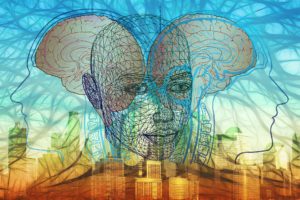There have been numerous terms used to describe the body’s response to chronic stress and the physiological response. The original descriptor was Tension Myositis Syndrome (TMS) coined by Dr. John Sarno in the 1970’s. Other terms have included
- Stress Illness Syndrome
- Psychosomatic Disorders
- Central Sensitization Syndrome (CSS)
- Mind Body Syndrome (MBS).
There are several more. They all describe the same constellation of symptoms created by an altered central nervous system and resultant chemical imbalance. For reasons that will become clear as you learn the DOC project I have chosen Neurophysiologic Disorder (NPD) as what I think is the most accurate description of the problem.
Thoughts are protective mental links to the environment. They cause chemical responses in your body that create anxiety, which enables you to survive. (not thrive). They are automatic, unconscious and hundreds of thousands of times more powerful than your conscious brain. That is the reason using rational means to solve problems arising from the unconscious brain is not effective.

“Recent neurological research has demonstrated that the brain has the capacity of neuroplasticity, or the ability to create new nerve circuits in response to life events. For example, when you learn to play the piano or swing a golf club, your brain cells have developed new pattens of connections that are manifested in your body. Billions of nerve connections are involved and are reinforced with repetition. What most doctors do not know is that pain can be caused by these types of learned circuits. Even when there’s no tissue damage in the body, such as a tumor, a fracture, or an infection, a learned set of connections can cause real, physical pain.” -Dr. Howard Schubiner-
- See how many NPD symptoms you have by taking Dr. Schubiner’s test. (He uses the term Mind Body Syndrome – MBS)
- Read Unlearn Your Pain by Dr. Howard Schubiner
DOC Principles Address NPD
The DOC model is a framework that organizes well-established spine care concepts. It allows you to organize your thinking and care to enable you to take full charge of your life. Your providers are resources and coaches. The concepts are the polar opposite of what most of us have been taught regarding how to manage pain and stress.
- Learn the framework of the DOC project.
- How does it apply to you?
- Use this website as an ongoing resource. It will be updated regularly.
My patients’ success is proportional to the degree of their commitment. I have observed a consistent improvement in my patients’ pain and quality of life. I am guessing that every person has at least three to five other NPD symptoms. I was experiencing 16 of the 33 symptoms during the worst part of my burnout. Most of these will also resolve.
Caring for my patients in chronic pain using the NPD approach has become the most rewarding and enjoyable aspect of my practice. This is a very unexpected development in this phase of my surgical career.
